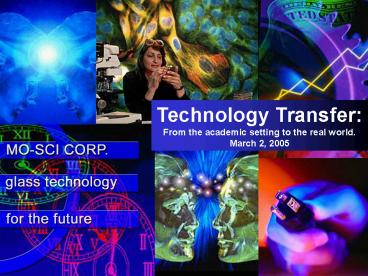Technology Transfer: - PowerPoint PPT Presentation
1 / 21
Title:
Technology Transfer:
Description:
2000-DOE Award for Low Energy Alternate for Silicates. 2002-DOE Award ... 2003-DOE Pending for High Alkaline Resistant Glass. Fibers for Concrete Reinforcement ... – PowerPoint PPT presentation
Number of Views:58
Avg rating:3.0/5.0
Title: Technology Transfer:
1
Technology Transfer From the academic setting to
the real world. March 2, 2005
2
- Founded in 1985 to develop and market high value
glass products. - Started with one part-time engineer
- Original product (TheraSphere) technology
- developed by Dr. Day and Dr. Ehrhardt at the
- University of Missouri-Rolla/Columbia
- Business philosophy adopted included using
- the assets of UMR to enhance MO-SCIs
- competitive advantage with big business
3
- Major products include specialty glass
microspheres, fibers, and frits used in the
health care industry - Health Care products include
- Cancer treatments
- Blood typing devices
- Dental filler materials
- Bioactive glasses (able to bond to hard
- and soft tissues)
- Composite reinforcement fibers
- Biodegradable implants
- Antimicrobial glasses
4
- Other Specialty Products include
- Night vision filter glass
- Bond line spacing materials used in
- aerospace
- automotive
- semiconductor
- transportation
- other industries
- High index (reflective) microspheres
- Specialty microspheres and fibers
- designed for customer specific uses
5
(No Transcript)
6
How has the SBIR program benefited MO-SCI, the
University, the State, the economy? What does
the taxpayer get for their money? Is the Program
worth continuing?
7
(No Transcript)
8
(No Transcript)
9
How has the SBIR Program benefited MO-SCI? Kept
research as a principle business
interest. Provided a means of sustaining the
Company during difficult economic times. Allowed
MO-SCI to perform important research that we
otherwise couldnt afford to fund
internally. Research performed under the SBIR
Program have/are leading to beneficial product
lines
10
How has the SBIR Program benefited UMR? Some of
the work performed has led to intellectual
property that can be patented. Access to SBIR
Program as a subcontractor. Support of graduate
student level research. Networking of University
personnel with small businesses.
11
How has the SBIR Program/University benefited the
economy of Missouri? Based on the TheraSphere
research that was performed at UMR, MO-SCI
Corporation was formed. The immediate effects
were primarily directed at improving the
delivery system for therapeutic radiation
treatment of inoperable liver cancers. The
following slide demonstrates the longer economic
impact of the spin off technology derived from
the University.
12
MO-SCI Corporation Economic Considerations
1985 2004 Employees 2 40 Taxes
paid 1000 gt750,000 Payroll
lt30,000 gt1,500,000 University of
Missouri Licensed technology has generated
400,000 in royalties. 8 US patents and 23
foreign patents have been issued
13
University of Missouri Technology MO-SCI Corp.
was founded to manufacture Theraspheres Clinical
trials FDA approval 1000 patients have been
treated
14
MO-SCI Corp. continues to work in partnership
with the University of Missouri-Rolla and
University of Missouri-Columbia MO-SCI and
University work together continuously to bring
research projects and dollars () into Missouri
15
Technology Transfer To the real world and back.
Project Example 1989-NIH Award for Fe-P
Composite Applications 1990-Results from work
lead to Nuclear Vitrification
Applications 2000-DOE Award for Low Energy
Alternate for Silicates 2002-DOE Award for
Nuclear Vitrification 2003-DOE Pending for High
Alkaline Resistant Glass Fibers for
Concrete Reinforcement
16
Technology Transfer To the real world and back.
Applications Outcome Medical Est.
Worth Bioresorbable composites 100,000,000/year
Infrastructure Concrete reinforcement 500,000
,000/5 years Energy Conservation Non-silicate
glass alternate 50,000,000/year
17
Technology Transfer To the real world and back.
Applications Outcome Environmental
Est. Worth Nuclear Vitrification
1,000,000,000/year Identified Land filled
renewable raw materials ???
18
Technology Transfer To the real world and back.
Collaborative Projects
These projects represent funding levels in the
millions of dollars either through direct
contracts or subcontracts between MO-SCI and the
University. The benefit to Missouri (Rolla) is
through new jobs being created and the taxes
being paid from them. By having contractual
agreements between the University and MO-SCI, we
have the ability to compete with larger
corporations giving us the opportunity to create
additional new jobs from new contracts.
19
Technology Transfer To the real world and back.
Collaborative Projects
Awarding Agency Title
DOD 1988 Superconducting Glass Fiber
NIH 1989 Bioabsorbable Glass Fiber Composites
NIH 1990 Bioabsorbable Glass for Arthritis
JJ 1991 In-vitro Blood Typing Devices
DOD 1992 High Strength Silicon Nitride Fibers
NIH 1993 Bioactive Glasses for Hyperthermia
3M 1993 Ionic Resin Glasses for Dental Use
DOD 1994 Algorithms for Ceramic Matrix
NSF 1995 Processing Pollucite Glass-Ceramics
20
Technology Transfer To the real world and back.
Collaborative Projects
Awarding Agency Title
NSF 1997 Minimizing Evaporative Colorants
BATF 1999 Development of Taggants for
Explosives EPA 2000 UV Transmissible Filler
Materials DOE 2000 Low Energy Silica Fiber
Alternatives DOE 2002 Fe-P Glass for Nuclear
Vitrification EPA 2003 Recycling of
Industrial Phosphate Waste DOE 2004 Iron
Phosphate Glass Fibers for Concrete
DOE 2004 Hydrogen Storage Project I
DOE 2004 Hydrogen Storage Project II
DOE 2004 Hydrogen Storage Project III
21
Technology Transfer From the academic setting to
the real world.
THANK YOU!































